Introduction
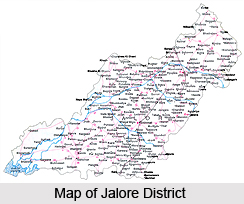 Jalore District is located towards the south-west of Rajasthan. The early name of Jalore was Jabalipur. The administrative headquarter of Jalore district is the Jalore city which is known as the Granite City of Rajasthan. A lot of mythological stories are associated with Jalore District. It is believed that Jalore district had existed since the time of Lord Rama in the Dwarpa Age. Historical evidences suggest that Jalore was a prosperous region and was ruled by the Pratihara Kings for quite some time. A number of brave men and women have added to the glory of Jalore as and when time passed by.
Jalore District is located towards the south-west of Rajasthan. The early name of Jalore was Jabalipur. The administrative headquarter of Jalore district is the Jalore city which is known as the Granite City of Rajasthan. A lot of mythological stories are associated with Jalore District. It is believed that Jalore district had existed since the time of Lord Rama in the Dwarpa Age. Historical evidences suggest that Jalore was a prosperous region and was ruled by the Pratihara Kings for quite some time. A number of brave men and women have added to the glory of Jalore as and when time passed by.
Location of Jalore District
Jalore District is located towards the south-western part of Rajasthan. The horizontal expanse of the district is between 24.48 degrees and 5 minutes north latitude and 25.48 degrees and 37 minutes north latitude. On the other hand longitudinally the district stretches between 71 degrees and 7 minutes east longitude and to the mid of 75.5 degrees and 53 minutes east longitude. Jalore District has an area of 10564.44 square kilometres. As per as the boundary of the district is concerned it can be said that the North Western border of the district is shared with Barmer, the North Eastern boundary is shared with Pali, towards South East is Sirohi and in south the ambit of Gujarat comes into force.
History of Jalore District
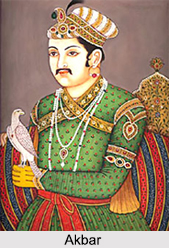 Jalore district or the erstwhile Jabalipur obtained its name from the sacred groove of Mahirishi Jabali. The District Head Quarter known is known as Jalore. As per the history of Jalore district, the Prathihara King Naresh Nagbhatt II expanded the ambit of his state from Arabian Sea to Bay of Bengal. Songara Chauhans who were ready to die for their nation and it is their pride that made Jalore their Capital by fighting it out. The three main towns Jalore, Bhinmal and Sanchore were ruled by Prathihar, Parmar, Chalukya, Chauhan, Pathan Mughal and Rathore dynasties.
Jalore district or the erstwhile Jabalipur obtained its name from the sacred groove of Mahirishi Jabali. The District Head Quarter known is known as Jalore. As per the history of Jalore district, the Prathihara King Naresh Nagbhatt II expanded the ambit of his state from Arabian Sea to Bay of Bengal. Songara Chauhans who were ready to die for their nation and it is their pride that made Jalore their Capital by fighting it out. The three main towns Jalore, Bhinmal and Sanchore were ruled by Prathihar, Parmar, Chalukya, Chauhan, Pathan Mughal and Rathore dynasties.
Before independence Jalore district was a part of Jodhpur province (Marwar). Administratively it was divided into three Parganas of Hukumats- Jalore Jaswantpura and Sanchore. History was written on 30th March 1949 when Rajasthan came into force and it was then Jodhpur province was incorporated into it and consequently Jalore had become a part of Jodhpur province. When various districts were made Jalore also made its presence felt on the scene and it was made into the district present day.
With the passage of time the name of mountain Kanchangiri and Swarngiri were also frequently used as names of Jalore. It is clear from Kuvalyamana of Udhyothan suri that in 8th Century A.D. it was a prosperous town. At that time Prathihar King Vatsa Raja was the ruler. Towards the end of 12th Century A.D. Parmars ruled the region. Historians believe that the Jalore Fort was built by Parmar rulers. At that time from Abut to Umarkot all landmass was ruled by the Parmar dynasty rulers: Chandan, Devraj, Aparajit, Vijjal, Dhasavarsh and Vishal had ascended the throne.
After A.D. 1164 Kumarpal rules here. Nadol king Arhan`s youngest son Kirtipal had started Chauhan tradition in Jalore. Samar Singh ascended after Kirtipal. After him Uday Singh like his father also captured Nadol and Mandore from Mohammedans. Thereafter Chargi Dev and Samant Singh became rulers upon whose valiant son, great poet, Padmanabhan had written an epic named "Kanhad Prabandh". In this epic there is fantastic elaboration of war between Kanhad Dev kings and Ala-ud-din Khilji.
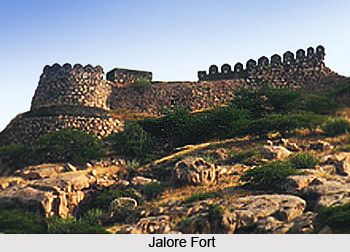 Fort at mountain Swarngiri provided name to the lineage of Chauhan`s as Songara Chauhan. According to a general belief the place derived its name for the heavy presence of Jal tree here. Rathore king, Rao Maldev, ruled the Fort of Jalore in 15th Century. During Akbar`s rule Abdul Rahim Khan Khana took it infinitely from Gazni Khan. Emperor Jahangir built the walls of the fort. After the death of Aurangzeb it permanently became a part of Jodhpur.
Fort at mountain Swarngiri provided name to the lineage of Chauhan`s as Songara Chauhan. According to a general belief the place derived its name for the heavy presence of Jal tree here. Rathore king, Rao Maldev, ruled the Fort of Jalore in 15th Century. During Akbar`s rule Abdul Rahim Khan Khana took it infinitely from Gazni Khan. Emperor Jahangir built the walls of the fort. After the death of Aurangzeb it permanently became a part of Jodhpur.
It is said with relation to Viram and Firoza that the Mughal Emperor had invited Viram for a game of "Veniti" with `Panju Wrestler.` After defeating the wrestler Princess Firoza fell in love with Viram and she had sent proposal of marriage, which Viram had rejected. Getting angry with this Mughal Emperor surrounded the whole Jalore with his soldiers. Hundreds of Rajput braves had laid down their lives for their country, religion and pride also brave women have put themselves alive into fire to save their respect.
In South West of Rajasthan Jalore District is located in the peripheries of sky high Swarngiri fort forming a fish shape and having a vast expanse of around 10640 sq. km. According to historical beliefs it was called as `Drumkulya` the northern part of southern Ocean. Being frightened from the `fire bow` of Lord Rama the sea had accepted to build a bridge on it and then he had fired this infallible bow leaving desirous landmass of Jalore. During Dwapara age this landmass was known as `Maru Dhanwa` consequently Marudhar and Marwar being the acceptable changes in name.
Geography of Jalore District
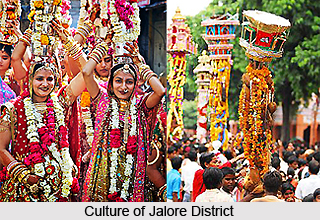 Jalore District is located at an altitude of 268 meters. It has a tropical or a half-tropical climate. The daily as well as the annual temperature of the region is quite high. The annual average rainfall of Jalore is 43.4 centimetres. The coldest month in Jalore district is January. During this time the temperature dips to around one or two degrees centigrade. On the other hand June is the hottest month of the year during when the temperature rises to as high as 41 or 42 degrees centigrade. Sometimes the temperature may be as high as 48 degrees centigrade. Jalore has huge deposits of old as well as new alluvial soils. The main river of the region is River Sukri which is a tributary of River Luna.
Jalore District is located at an altitude of 268 meters. It has a tropical or a half-tropical climate. The daily as well as the annual temperature of the region is quite high. The annual average rainfall of Jalore is 43.4 centimetres. The coldest month in Jalore district is January. During this time the temperature dips to around one or two degrees centigrade. On the other hand June is the hottest month of the year during when the temperature rises to as high as 41 or 42 degrees centigrade. Sometimes the temperature may be as high as 48 degrees centigrade. Jalore has huge deposits of old as well as new alluvial soils. The main river of the region is River Sukri which is a tributary of River Luna.
As far as the fauna of Jalore District is concerned in the present age a number of wild animals are to be found in the region.
Demography of Jalore District
According to the census of 2001, Jalore District has a population of 1448940. Density of population in the district is 136 persons per square kilometre. The number of males in the district is 737880 and the number of females is 711060. In Jalore there is more number of rural populations in comparison to the urban population of the district. The rural and urban population of Jalore is 1338946 and 109994 respectively. The literacy rate of Jalore is as low as 46.05 percent. As far as literacy rate is concerned, 64.7 percent males are literate and only 27.8 percent females are literate in the district of Jalore.
Culture of Jalore District
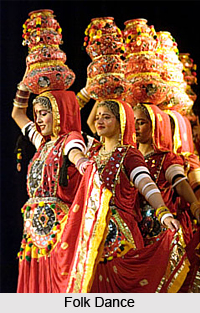 For centuries Jalore district had been a centre of literature and Culture. The remains of the Indus civilization found in Alana village, describes the antiquity of the district. Hindu kings provided special motivation to art and literature. From the olden days, Jalore has been a sacred place of the Jains. Shaiwa and Jaina were two important religions of this region, and both were important aspects of this region. Many temples were built during that time. In all probability, the Adinath Temple is the oldest of all. It was there in the 8th Century A.D. that Udhyatan suri had written kuvalyamana. He had written Tripitaka upon Haribhadra Suri`s eighth edition. His brother BuddhiSagar wrote `PanchGranthi Vyakaran`(Five Volumes of Grammar).After 1200 A.D. Aasing, a literary genius, wrote `Jeevdaya Ras` and `Chandan Bala Ras`. Raja Uday Singh`s minister Yashoveer was also much accomplished. He was proficient in both art and poetry. The Middle Ages provided an ideal ground for the Jain Saints to write in old Hindi.
For centuries Jalore district had been a centre of literature and Culture. The remains of the Indus civilization found in Alana village, describes the antiquity of the district. Hindu kings provided special motivation to art and literature. From the olden days, Jalore has been a sacred place of the Jains. Shaiwa and Jaina were two important religions of this region, and both were important aspects of this region. Many temples were built during that time. In all probability, the Adinath Temple is the oldest of all. It was there in the 8th Century A.D. that Udhyatan suri had written kuvalyamana. He had written Tripitaka upon Haribhadra Suri`s eighth edition. His brother BuddhiSagar wrote `PanchGranthi Vyakaran`(Five Volumes of Grammar).After 1200 A.D. Aasing, a literary genius, wrote `Jeevdaya Ras` and `Chandan Bala Ras`. Raja Uday Singh`s minister Yashoveer was also much accomplished. He was proficient in both art and poetry. The Middle Ages provided an ideal ground for the Jain Saints to write in old Hindi.
Jalore`s Bhinmal town was a popular centre of education. It was the capital of Gujarat till the first half of the 7th Century A.D. According to Bhinmal Mahatmaya, the district was formerly known as Gautamshram, later it came to be known as Shrimal, then Pushpmal and in Kalyug became known as Bhinnmal or Bhinmal. According to the Prabhavahak Charit and Prabandh Sangrah, Bhinmal was a very prosperous town and an important stronghold of the Pratihara Empire. From the highlands one could see Patan of Gujarat.
Bhinmal is the birthplace of the great Sanskrit poet Maagh, and therefore occupies an honoured place. The poet Maagh lived during the 8th and 9th centuries. In the epic named Shishupal Vadh written by Maagh there is an excellent mixture of Kalidasa`s expression, the Art of Bhaarwi, Bhutti`s Grammar and Garniture. In this well executed work, the words have been very rhythmically aligned, making it a great work of art. The co-relation between `Madira` and Pramda` in Maagh`s epic is symbolic of North India`s Rajput lifestyle during 8th to 10th Century A.D. King Bhoj`s name is worth mentioning among the friends of Maagh. He built the sun temple in Bhinmal and the Sanskrit school in Jalore.
Rajasthan`s immortal hero Maharana Pratap Singh had a great affiliation for Jalore. Jayanti Devi the daughter of Songara Akheraj Chouhan, gave birth to Rajasthan`s independence hero Maharana Pratap. It is said that Maharana Pratap spent a lot of his time here in the Sugandgiri mountain ranges. In Jalore`s Panchayat Samiti area Jaswantpura near Dantlawas village there is a very soothing destination named Sundha Mata in the nearby mountains. A number of pilgrims visit the place from Gujarat and all over the place. In Bhadrajun village there is found a Subhadra temple, and is said that Subhadra and Arjuna both rested there.
Administration of Jalore District
Jalore District has been divided into five sub-units namely Ahore, Jalore, Bhinmal Raniwara and Sanchore. There are also 767 revenue villages in the district. For revenue administration Jalore, Ahore, Bhinmal, Raniwara, Sanchore, Sayala and Bagoda had been provided with Tehsil Officer whereas Bhadrajun and Chitalwana have Sub-Tehsil Office. For proper functioning of developmental activity Seven Panchayat Samiti Offices have been established at Jalore, Bhinmal are Sayala. Three Municipalities are situated at Jalore, Bhinmal and Sanchore. In Jalore 264 Gram Panchayat villages have been formed.
For instituting democratic laws of governance Jalore-Sirohi is jointly one parliamentary constituency. There are five legislative assembly areas namely Jalore, Ahore, Bhinmal, Raniwara and Sanchore Members of Lok Sabha and Legislative Assembly.
Economy of Jalore District
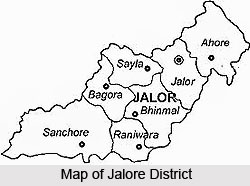 Economy of Jalore district is dependent on agriculture to a great extent. The main crops grown in the district are food grains, pulses, oilseeds, sugarcane and cotton. Agro-based industries also function here in a major way, though there is scope for much development. In order to help and guide new industrial units in the district of Jalore, the District Industry Centre, Rajasthan Finance Corporation (RFC), RIICO, and Rajasthan Khadi Gramodyog Board offices are established here. RIICO has developed 4 industrial areas in Jalore District viz Jalore, Bishangadh ,Sanchore and Bhinmal. In Jalore city RIICO has established 3 phase industrial areas. And fourth phase is been proposed at Bagra, 900 Bigha of land area has been under planning. This area may accommodate nearly 500 new industrial units. District has only one Medium Scale Industry, Jalore-Sirohi Milk Cooperative Society Ltd, Raniwara Dairy it produces skimmed milk powder and various milk products, it has 2500 Metric Ton per year and 5 ton per day production capacity.
Economy of Jalore district is dependent on agriculture to a great extent. The main crops grown in the district are food grains, pulses, oilseeds, sugarcane and cotton. Agro-based industries also function here in a major way, though there is scope for much development. In order to help and guide new industrial units in the district of Jalore, the District Industry Centre, Rajasthan Finance Corporation (RFC), RIICO, and Rajasthan Khadi Gramodyog Board offices are established here. RIICO has developed 4 industrial areas in Jalore District viz Jalore, Bishangadh ,Sanchore and Bhinmal. In Jalore city RIICO has established 3 phase industrial areas. And fourth phase is been proposed at Bagra, 900 Bigha of land area has been under planning. This area may accommodate nearly 500 new industrial units. District has only one Medium Scale Industry, Jalore-Sirohi Milk Cooperative Society Ltd, Raniwara Dairy it produces skimmed milk powder and various milk products, it has 2500 Metric Ton per year and 5 ton per day production capacity.
In terms of industries, the granite industry features in a big way in the economy of the district. Jalore is called the Granite Capital of Rajasthan and it is famous for its high quality lakhaa granite. The Granite industry has developed radically after recession. In Western Rajasthan`s Jalore district, Jodhpur district, Barmer district, Pali district and Sirohi district granite industry is developing very fast. Out of it Jalore is the front runner. The work of making tiles from this stone was firstly started here. In the Jalore district, around 70-80 mines are being used for the granite industry. The stone of each mine has a different colour here and is of strong texture. Most preferred stones are Jalore, Noon, Leta, Pijopura, Raniwara, Tawab, Khambi, Dhawla, Bhetala and Nabi. The stone of Pijopura mine is the most expensive and second most expensive is Gadh Siwana. There are some 400 cutting and polishing units in Jalore presently running. An average of 8 to 10 workers work in each unit.
There are a number of other established industries that also contribute towards the economy of Jalore district. Handloom work is done at Leta, Jelatara, Degaon, Pur, Vodha, Vasandevda, Lalpura, Bhatip, Khara, Gundau. Bhinmal is famous for its Leather traditional footwear (Juti).
Thus discussed above is the economy of Jalore district. Jalore has a wide potential in industrial sector that has to be exploited properly.
Dances of Jalore District
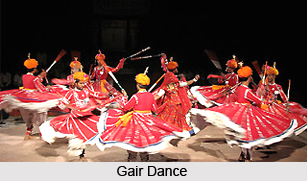 Dance forms of Jalore district are varied in their nature and performance styles. There are many different dance forms prevalent in the district, performed on occasions and festivities. While some dances are performed by males, others are performed by both men and women. Also while some dances are performed for marriage functions and other festivities, others are performed specifically during or after Holi. Thus the dances differ in range of performance. The point of similarity between the different dances would be that most of them are performed to the tune of beat drums and plates, and are accompanied by folk music typical to the style of performance. The various dance forms of Jalore district are discussed below.
Dance forms of Jalore district are varied in their nature and performance styles. There are many different dance forms prevalent in the district, performed on occasions and festivities. While some dances are performed by males, others are performed by both men and women. Also while some dances are performed for marriage functions and other festivities, others are performed specifically during or after Holi. Thus the dances differ in range of performance. The point of similarity between the different dances would be that most of them are performed to the tune of beat drums and plates, and are accompanied by folk music typical to the style of performance. The various dance forms of Jalore district are discussed below.
Dhol Dance
This dance is performed on the occasion of marriage by the Malis, Dholis, Sargaras and people of Bhil communities. Sargaras and Dholis are professional folk singers and drum beaters who are very proficient in this art. Dhol is predominantly a male dance, where 4 to 5 drums are beaten consecutively. When the dance commences, the leaders beat their drums in `Thakna Shaili`. As soon as Thakna ends some dancers put swords in their mouth, some have lathis and others take a handkerchief in their hands, and thus the dance starts. It this dance common people can also take part with professionals.
Dandiya Dance
A group of 20-25 males with long sticks in their hands, move around in a sequential pattern in this dance form. The dancers beat their sticks and dance parallel to each other. The dancers wear fancy dresses depicting Kings, traditional Moneylenders (Sahukaars) Saint Shivaji, Lord Rama and Sita and acts like them. This dance starts after the festival of Holi and continues for many days. When the dance is being performed, Shehnai players, Nagada beaters and singers sit in the middle of the stage. The male singers sing the lengthy songs called folk loris. Also, Dhamal and dance oriented Holi songs are sung. In these songs there are praises of Bhairuji of Badli most of the times. Gair dance, Girad and Dandiya dance have many similarities, but they differ in terms of leg work, facial expressions, rhythm, songs and attire.
Gair Dance
This dance is also mainly performed by the males. The dancers dance around with long sticks. In it, many males dancing together form different groups. Drums, Baakiya and Plate (Thaali) are used for playing music, with the musicians performing in the midst of the dancers. Folk songs influenced by `Shringar Ras` and `Bhakti Ras` are also used in this dance. Dancers wear white clothes from shoulder to waist, and a leather belt is tied. In the belt, there is also a place for keeping a sword and frills are tied on to the turban. The facial expression of dancers expressing divine expressions is enough to attract anyone. The dancers are called Gairiya. This dance starts the day after Holi and lasts for 15 days. All the people of the area take part in the dance, like Malis, Purohits, Choudharys, Rajpurs, Meghwals etc. Many Gair dancers of district have earned national andInternational fame. Some Gair dancers have also had the opportunity to show their art in the Republic day function held in Delhi.
Loor Dance
This dance starts month before Holi and ends with Holika`s destruction. It is a female dance. After concluding their work at home in the evening they converge in an open or any other convenient place and the performances are held. As many women can take part in the circle, a huge circle is made while dancing. The dance is also conducted community wise by women in their streets, but in the general space reserved for Loor in the village, any community member can take part. Women of all ages and unmarried women can also take part.
Shakur Dance
This dance signifies the hunting of the wild pig, accompanied by the beating of drum plates and small round bells. It is dance of rural background. Bijaram, a resident of Bijli village has given it a national identity with performances at Lok Utsava Ajmer, Lok Utsav Delhi and North area Cultural Centre Patiala. He has also performed at Chandigarh, Sikkim, and Siliguri.
Matki Dance
This dance form is all about dancers carrying filled pots on their uncovered heads and dancing to the rhythm of drums and plates.
Chang Dance
Though Chang dance is performed in all of Rajasthan, it acquires a distinct character in Jalore accompanied by folk songs. There are many people from different castes who sing to the performance of Chang.
Handicrafts Industry in Jalore District
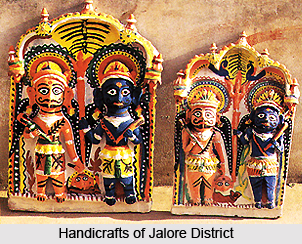 Handicrafts Industry in Jalore district is varied in type and production. The handicrafts industry in the district of Jalore produces a number of items, ranging from objects of everyday essential use like utensils and shoes to unique showpieces typical to the district such as artefacts of granite, wooden toys paintings etc. Due to the easy availability of granite in the district, artefacts made of granite are produced in a big way here. These include paintings, name plates, chakla, kharal etc. The various items produced by the handicrafts industry in Jalore district are discussed below.
Handicrafts Industry in Jalore district is varied in type and production. The handicrafts industry in the district of Jalore produces a number of items, ranging from objects of everyday essential use like utensils and shoes to unique showpieces typical to the district such as artefacts of granite, wooden toys paintings etc. Due to the easy availability of granite in the district, artefacts made of granite are produced in a big way here. These include paintings, name plates, chakla, kharal etc. The various items produced by the handicrafts industry in Jalore district are discussed below.
Wooden Toys
In Ramdeo Colony of Jalore district headquarters is located a small cottage industry of wooden toys. Old and Middle Ages artistic imitations of wood are made here. Dolls, face masks, birds, animals swings, bullock carts, chowki etc are all made in wood. Jalore Panchayat Samiti`s Akoli, Leta, Bagra, Deegoan, Chandna, Siyana, Chura and Sarat villages are engaged in this industry. Panchayat samiti Ahore`s Ghana and Ahore itself, Sanchore Panchayat Samiti`s Akoli, Panchayat Samiti Jaswantpura`s Ramseen, Mudtara-Sili and Punang Kala and Bhinmal`s Panchayat Samiti`s Juna Rauta and Borta, and in Raniwara Panchayat Samiti`s Bhatip, Kodka and Adarvada villages are employed in building toys from wood.
Woollen Handicraft -Khesla, Dari, Patte, Galicha(Carpets)
Within a circle of 5 kilometres of Jalore, nearly 100 families are employed in this type of handwork and it is run as a family business. They make woollen blankets known as Khesala and Pattu weaving in the local area. Leta`s Khesala is famous in the whole of Marwar region. Handloom Development Corporation has established a small industry in this village. Here, cotton Khes and woollen blankets are made. A small industry has been developed in the Jalore district headquarters by the Veeram Khadi Sangh Siyana. It is known for the well made woollen daris. Panchayat Samiti Sanchore`s Dedva, Ranodar, Jhotra, Dhamana and Lalpura are also engaged in the making of Woollen Pattu. Dari -Kaalin(Carpet) is woven at Sirana of Sayla block, Nasoli of Bhinmal Block, Borta and Nimbawas of Bhinmal Block. Clothes are woven at Narta and Bareta Dhani. Pattu is made at Bagotara. Batip, Deegaon and Sevada of Raniwara tehsil are also engaged in cloth weaving.
Utensils and idols of Soil:
Utensils made of soil as well as idols, toys, Gangaur, horses, horse-ridesr ,horses of Mamaji and many more artistic items are made at Panchayat samiti Jalore`s Deegoan, Chandana, Siyana and Chura villages, Panchayat samiti Ahore`s Dayalpura, Paota, Ahore and Harji villages, Panchayat Samiti Jaswantpura`s Mudtara Silli and Bhutwas villages, in Sayala Panchayat samiti Avloj village,Bhinmal Panchayat samiti`s Juna Rauta,Naya Rauta,Borta,Bagora,Khera, Juni Morseem, Fagotara and in Kaleti villages, Panchayat samiti Raniwara`s Dhanwara,Ropsi,Samrani, Kot Ki Dhani and in Singawas villages Cheelam and Hukkas are made in Mandoli.
Shoe Making:
Shoes made in Jalore, Bhinmal and Badgoan are famous all over Marwar. Apart from these Chandna, Nimbla, Mudatrasilli, Mandwala, Balwara, Borta ki Dhani, Navapura, Mindavas, Bagoda, Bali, Bargaon, Roopavati kala,Ropasi, Aaldi, Bhatip, Kotka, Samrani and Jalora khurd villages are the centres of leather works like colouring and designing shoes.
Artefacts of Granite:
Due to the easy availability of granite in the district, artefacts made of granite are produced in a big way here. The various coloured and polished stones found in the district are worked upon and beautiful works of art are produced. Paintings made on the tiles include those of chariots led by Lord Krishna, Ganpati, Lord Hanuman, Bhairuji, Maharana Pratap Singh, Mahaveer Swami and women in Manipuri dresses and watches as well. Apart from this, name plate, pen stand, Chakla, Kharal, ashtray and key chains of different types are also produced.
Paintings
Beautiful traditional paintings are made by painters in the villages and towns of Siyana, Noon, Guda Balotan, Basda Dhanji, Punang Kala, Sayala, Bagoda, Nandiya, Nasoli, Narta, Dhumadbiya, Samrani, Jalore, Sanchore etc.
Tourism of Jalore District
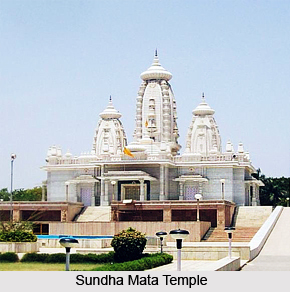 Jalore district is an interesting place which serves as an important tourist destination. Number of tourists throngs the district throughout the year in order to enjoy the various places of tourism which are present in the district. The well known tourist destinations of Jalore District include religious as well as historical places of interest.
Jalore district is an interesting place which serves as an important tourist destination. Number of tourists throngs the district throughout the year in order to enjoy the various places of tourism which are present in the district. The well known tourist destinations of Jalore District include religious as well as historical places of interest.
A place of religious importance of Jalore District is the Sundha Mata Temple. Sundha Mata Temple is located at 1220 meters height in the Aravalli mountain ranges. On Sundha Mountain is the temple of goddesses Chamunda Devi which is a very sacred place for devotees. It is 105 Km from the district headquarter and 35 Km. from sub divisional Bhinmal. This place lies in Raniwara Teshil in the midst of Malwara to Jaswantpura Road near Dantlawas village. Numerous tourists from both Gujarat and Rajasthan visit the place in huge numbers. The environment here is afresh and attractive. Sundha temple is made up of while marble, the pillars reminds the art of Abus`s Delwara temple pillars. A very beautiful idol of goddesses Chamunda is present under the huge stone.
In front of mother Chamunda a BhurBhuva Swaweshwar a Shivaling has been established. The Sundha inscription is of peculiar importance in historical sense-like the Harishen inscription or Delhi`s Mehrulli pillar inscription. Sundha inscription also throws light on the history of India.
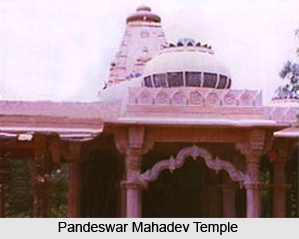 In the main temple idols of Lord Shiva, Goddess Parvati and Lord Ganesh`s idol are considered very old and extinct. During Navratri tourist from Gujarat and nearby areas comes in hug mass.
In the main temple idols of Lord Shiva, Goddess Parvati and Lord Ganesh`s idol are considered very old and extinct. During Navratri tourist from Gujarat and nearby areas comes in hug mass.
Jalore District is known for its antique past. Several forts and palaces testify the royal past of the district.
Pride and prestige of Jalore is its fort that sings its own story of valour and strength. This fort is a property of State Government`s archaeological department and a protected building since 1956. To go to Jalore fort one has to go through zig-zag roads through the mid-town.
Among temples the temple of Parshavnath is the grandest of all. The idols sculpted on the walls in the back side of temple attract visitors the most.
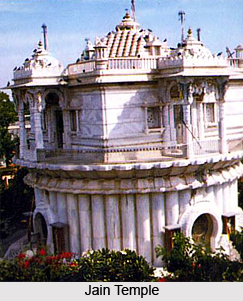 Moving from the four faced Jain Temple to the palace of Man Singh, one pillar of Parmar dynasty stands reserved on a small platform. Probably this is the only memorial of Parmars. The human height red stone`s pillar instantly speaks out the beauty of its artistic sculpting.
Moving from the four faced Jain Temple to the palace of Man Singh, one pillar of Parmar dynasty stands reserved on a small platform. Probably this is the only memorial of Parmars. The human height red stone`s pillar instantly speaks out the beauty of its artistic sculpting.
In the middle of Jalore District are the remains of a great Sanskrit School which dates back to the times of King Bhoj. Presently the school is known by the name Topkhana. Every pillar of the school attracts visitors for hours of its tiny stone carvings. It is an example of the beauty of middle ages art. The engravings of flowers, chains, elephant, bells, vines are basically in the form of geometric figures. In the main premise one room is built 10 feet above earth in the right corner, stairs are built to lead there.
Sire Mandir Temple is famous for its natural beauty belief and austerity. Sire temple is the abode of Lord Shankar and was built by Raja Ratan Singh. The Ratneshwar Temple, on the other hand, is famous for its vastness. Besides the Sundha Mata Temple of Jalore District the other religious places of the area are Sevadas Pataleswara, Jaganath Mahadev, Neelkanth Mahadev, Jahaz Temple Mandala. There is also a Jain Temple in Bhandavpur and a Jain Temple at Bakra Road.
Some of the other important forts of Jalore District are Fort of Bhadrajum, Fort of Kota Kosta.



















